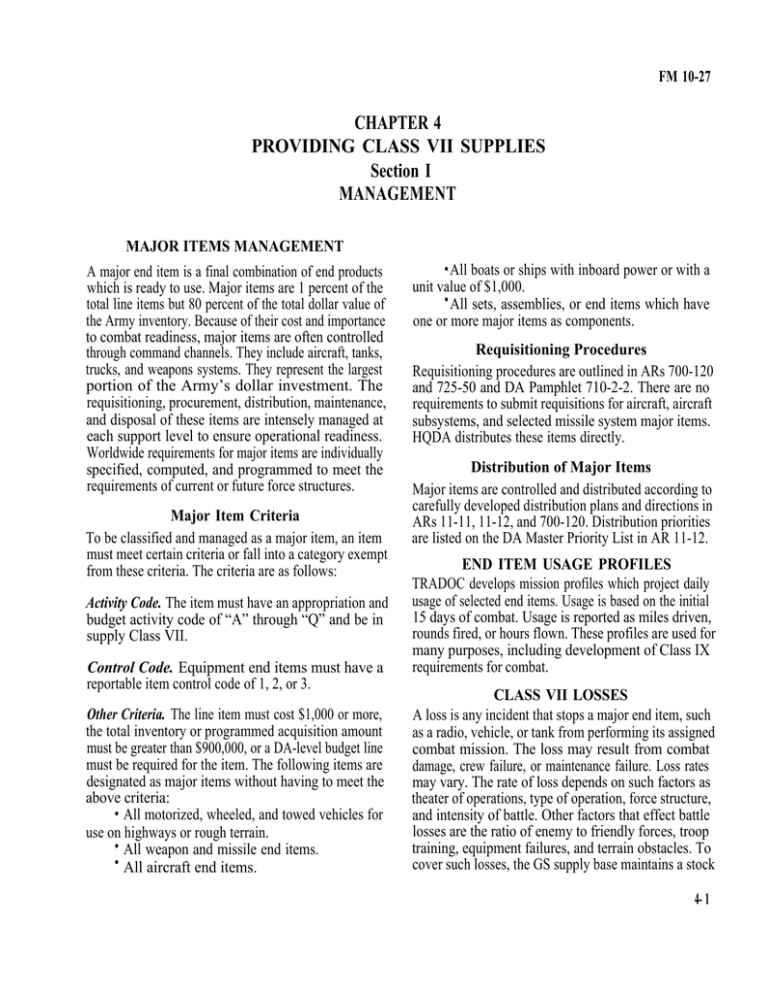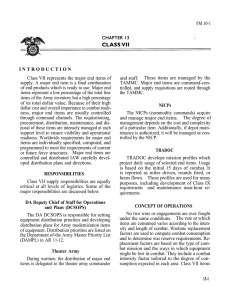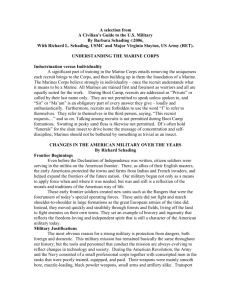CHAPTER 4 PROVIDING CLASS VII SUPPLIES Section I MANAGEMENT
advertisement

FM 10-27 CHAPTER 4 PROVIDING CLASS VII SUPPLIES Section I MANAGEMENT MAJOR ITEMS MANAGEMENT A major end item is a final combination of end products which is ready to use. Major items are 1 percent of the total line items but 80 percent of the total dollar value of the Army inventory. Because of their cost and importance to combat readiness, major items are often controlled through command channels. They include aircraft, tanks, trucks, and weapons systems. They represent the largest portion of the Army’s dollar investment. The requisitioning, procurement, distribution, maintenance, and disposal of these items are intensely managed at each support level to ensure operational readiness. Worldwide requirements for major items are individually specified, computed, and programmed to meet the requirements of current or future force structures. Major Item Criteria To be classified and managed as a major item, an item must meet certain criteria or fall into a category exempt from these criteria. The criteria are as follows: Activity Code. The item must have an appropriation and budget activity code of “A” through “Q” and be in supply Class VII. Control Code. Equipment end items must have a reportable item control code of 1, 2, or 3. Other Criteria. The line item must cost $1,000 or more, the total inventory or programmed acquisition amount must be greater than $900,000, or a DA-level budget line must be required for the item. The following items are designated as major items without having to meet the above criteria: • All motorized, wheeled, and towed vehicles for use on highways or rough terrain. • All weapon and missile end items. • All aircraft end items. • All boats or ships with inboard power or with a unit value of $1,000. • All sets, assemblies, or end items which have one or more major items as components. Requisitioning Procedures Requisitioning procedures are outlined in ARs 700-120 and 725-50 and DA Pamphlet 710-2-2. There are no requirements to submit requisitions for aircraft, aircraft subsystems, and selected missile system major items. HQDA distributes these items directly. Distribution of Major Items Major items are controlled and distributed according to carefully developed distribution plans and directions in ARs 11-11, 11-12, and 700-120. Distribution priorities are listed on the DA Master Priority List in AR 11-12. END ITEM USAGE PROFILES TRADOC develops mission profiles which project daily usage of selected end items. Usage is based on the initial 15 days of combat. Usage is reported as miles driven, rounds fired, or hours flown. These profiles are used for many purposes, including development of Class IX requirements for combat. CLASS VII LOSSES A loss is any incident that stops a major end item, such as a radio, vehicle, or tank from performing its assigned combat mission. The loss may result from combat damage, crew failure, or maintenance failure. Loss rates may vary. The rate of loss depends on such factors as theater of operations, type of operation, force structure, and intensity of battle. Other factors that effect battle losses are the ratio of enemy to friendly forces, troop training, equipment failures, and terrain obstacles. To cover such losses, the GS supply base maintains a stock 4- 1 FM 10-27 of Class VII items equal to 10 percent of authorized end items in the corps or TAACOM. WARTIME REPLACEMENT FACTORS No two wars or engagements are ever fought under identical conditions. Environmental conditions vary throughout the world. The rate at which items are consumed varies according to the intensity and length of combat expected. Wartime replacement factors are used to compute combat consumption and to determine war reserve requirements for some allies. Replacement factors are based on the type of combat mission and the ways in which equipment might be lost in combat (enemy action, abandonment, or pilferage). They also include a combat-intensity factor tailored to the degree of consumption expected in each oversea area. Classified wartime replacement factors are available from the Deputy Chief of Staff for Operations and Plans, ATTN: DAMO-FDL, Washington, DC 20310-0400. WEAPONS SYSTEMS REPLACEMENT Weapons systems have a high priority for evacuation, repair, and transportation assets. Critical Class VII items are moved to covering force units. Transportation used for backhaul may have to be allocated to move critical weapons systems to the rear. Weapons systems replacements may be issued from pre-positioned war reserve stocks in the corps. Items must be ready for issue within a few hours. Weapons systems may also be sent from CONUS to a QM heavy materiel supply company, GS. From there, they are normally shipped to the division and then by heavy equipment transporter to the battalion. Though it is not a desirable procedure, motorized weapons systems may be driven under their own power. The DSA is the primary linkup point for weapons systems and crew. At the linkup, the weapon system and the crew are joined and briefed. Weapons systems must arrive in the DSA in a ready-to-fight condition. If the tactical situation prevents linkup in the DSA, linkup may occur at QM heavy materiel supply companies in the corps. A WSM is normally assigned to each level of command. The extent of control depends on the level of command. Details are in FM 63-2. Battalion The battalion executive officer serves as the WSM. The S3 recommends allocations for replacement weapons 4-2 systems. Allocation is based on tactical priorities set by the battalion commander, S1 strength reports on weapons crews, and S4 reports on available assets. The WSM matches available end items and personnel to maximize the number of available weapons systems within the battalion. Combat loss and asset data are provided in S4 logistics status reports. These are updated by spot battleloss reports. Brigade Since the division provides weapons systems directly to the battalions, the brigade is not normally involved in allocating weapons systems. The brigade executive officer may act as the WSM for the brigade. Division The DISCOM commander designates a WSM for the division. He is usually the ADMMO. The DMMC property book Class VII section keeps the WSM advised of the status of weapons systems components. The WSM must also coordinate with the maintenance management officer regarding the status of items being repaired in DS maintenance units. Allocation priorities are set by the division commander. Corps The WSM is the COSCOM’s weapons systems branch chief. Priorities are set by the corps commander who normally accepts the priorities set by the major unit commanders. OPERATIONAL READINESS FLOAT In the light infantry divisions only, the ORF is a pool of additional end items or components in DS maintenance units. ORF items are issued only when items cannot be repaired in established time limits to meet the supported unit’s needs. Serviceable ORF items are exchanged for like unserviceable but reparable end items. The exchange is a property book transaction. The unserviceable item then becomes a float item that requires immediate repair. The item is issued only if the maintenance request has a PD of 01 through 06 and the repair time is expected to exceed maximum allowable repair time limits. The theater commander prescribes wartime repair limits. AR 750-1 prescribes ORF policy. Because of the temptation to misuse ORF assets, AR 710-2 sets FM 10-27 restrictions on when these items can be used. Essentially, ORF items cannot be used to replace a supply shortage. Issue Controls Issue of ORF items is rigidly controlled. Levels of control include the-• Theater, corps, or DISCOM commander who establishes policies and procedures for control and use of ORF stocks. • Separate brigade or division commander who establishes the stockage level within limitations outlined by higher headquarters. • MMC which maintains the ORF lists. • Nondivisional maintenance company shop officer and SSA accountable officer managing the ORF within the policies and guidelines of MACOM commanders. Stockage Criteria AR 750-1, Chapter 6, lists ORF stockage criteria. HQDA decides which items are eligible for stockage. An ORF item must be a principal item selected for war reserve stockage. It must have a line item number and be listed in SB 710-1-1. Commodity commands select end items for ORF support. Stockage policy for ORF items differs from that for other items. Formulas used to compute wartime requirements are in AR 750-1 and DA Pamphlet 710-2-2. Section II CLASS VII SUPPLY REQUIREMENTS MAJOR END ITEMS Class VII supplies include nearly 9,000 line items. These are authorized by TOEs or MTOEs and CTAs. About 20,000 NSNs for Class VII items are listed on the AMDF. All items are ready for their intended use. Requirements Class VII items are stocked and distributed in support of TOEs for existing forces. The demand for these items depends on the intensity of battle. Replacement is based on combat losses. The sustaining level for Class VII supplies is 10 percent of the authorized end items in the corps or TAACOM. Requests for additional or replacement Class VII items are generally based on TOE or other authorization documents. Requests may be processed through command channels. Consumption Rates Use consumption rates when estimating supply and storage requirements. These requirements may vary depending on force structure, mission, areas of operation, and intensity of combat. FM 101-10-1/1 sets the consumption rate for Class VII at 15 pounds per person per day. More current rates may be available from the Commander, US Army Combined Arms Support Command, ATTN: ATCL-OPF, Fort Lee, VA 23801-6000. INVENTORY REQUIREMENTS AR 710-2 sets policy for inventories at the user and retail levels. Components must be inventoried when the end item is inventoried. Additional inventory requirements are based on events or the type of item. Event-Oriented Inventory Requirements Items must be inventoried upon-• Receipt, turn-in, or issue of the items. • Change of responsible officer. • Change of custody of arms storage facility. • Direction of the commander. • Annual responsible officer inventory. • Annual property book inventory. Weapons and Serial Number Inventory Weapons must be inventoried monthly by serial number. Also, serial numbers must be compared quarterly with those recorded on the property book. Sensitive and Pilferable Item Inventory All sensitive items other than weapons and ammunition must be inventoried quarterly. Items to be inventoried 4-3 FM 10-27 are identified with a physical security code of "1" through "6," "8," "9," "Q," "R," or "Y." The hand-receipt holder or subhand-receipt holder must inventory sensitive items listed on hand receipts or subhand receipts. The property book officer must inventory those items not listed on hand receipts. Wartime Requirements Inventories during wartime must be conducted as time allows. Any discrepancies found have to be recorded, but they do not have to be reported. SSAs should conduct only cyclic inventories. Using units may perform inventories to determine quantities on hand and property conditions. Section III DISTRIBUTION OF CLASS VII SUPPLIES THEATER SOURCES The QM heavy materiel supply company receives, stores, and issues GS-level Class VII supplies in the corps and COMMZ. DS supply companies employed in the division area, corps rear area, and COMMZ provide DS-level Class VII supply. In the heavy or infantry divisions, the S&S company, MSB, provides Class VII supplies to supported units in the DSA. The supply company, FSB, provides these supplies in the BSA. In the light divisions, the headquarters and supply company, MSB, provides supplies in the DSA. The headquarter and supply company, FSB, provides supplies in the BSA. The S&T company supports separate brigades and the S&T troop supports the ACR. For more details, including the amount of support, see FM 10-27-2. THEATER REQUISITION AND DISTRIBUTION FLOW Figures 4-1, page 4-5, and 4-2, page 4-6, show the requisition and distribution flow of Class VII items during transition-to-war and sustained-war phases. During the transition phase, combat losses are replaced from theater war reserves released to the corps. During the sustained-war phase, stocks from CONUS war reserves and CONUS depots are used to replenish the 30-day sustaining stocks in TAACOM GSUs. During the transition phase, MMCs base replenishment DSU and GSU requisitions on anticipated combat losses and combat-loss reports. During the sustained-war phase, MMCs compute replenishment requisitions based on accumulated demand history. Because of their importance, selected Class VII weapons systems are controlled by the TAMMC. All requirements for controlled items must go through the TAMMC. 4-4 Requisitions for controlled items flow from the DMMC to the CMMC. CMMCs and TAACOM MMCs forward requisitions for controlled items to the TAMMC. Division Support Area The property book officer in the DMMC is the major item manager in the division. He redistributes assets in the division to minimize shortages and requisitions from higher sources of supply to fill only those requirements which cannot be satisfied internally. Corps Rear Area Nondivisional units in the corps submit requests for Class VII supplies to their supporting DS supply company. This company transmits the requests to the CMMC. The CMMC also receives Class VII requests from divisional MMCs and separate brigade and regiment MMCs. Requisitions for controlled items are transmitted to the TAMMC. Corps DSUs and GSUs do not submit replenishment requisitions. The CMMC maintains accountable records, keeps track of their reorder points, and transmits replenishment requisitions, as necessary, to the TAMMC. The CMMC submits a daily battle-loss report to the TAMMC for end items issued from the GS supply base to replace battle losses. It submits requisitions to the TAMMC to replace Class VII items turned in to echelons above corps for maintenance. Item on hand. If the item is on hand in the QM heavy materiel supply company and is not a controlled item, the CMMC cuts an MRO directing the issue. Depending on transportation assets, the unit may send one of its own vehicles to the company to pick up the item. Arrange other transportation through the corps MCC. FM 10-27 Item not on hand. When the item is not on hand in the supporting QM heavy materiel supply company, the CMMC passes the request to the TAMMC. The TAMMC either directs issue from a TA QM heavy materiel supply company to the corps QM heavy materiel supply company, or, if stocks are not on hand, it passes the requisition to the CONUS NICP. The NICP directs release from the appropriate depot, and the depot ships stocks to the CONUS A/SPOE. The A/SPOE passes stocks to the A/SPOD where they are reprocessed and moved by surface transport to TA GSUs for issue to corps GSUs, or they are throughput from the A/SPOD directly to the consignee. Communications Zone Units in, or passing through, the COMMZ submit requests for Class VII supplies to their supporting DS supply company. That company transmits requests to the TAACOM MMC. The TAACOM MMC prepares and transmits requisitions for controlled Class VII items to the TAMMC. The TAACOM MMC submits daily battle-loss reports to the TAMMC for end items issued from GS support bases to replace battle losses. The TAMMC distributes Class VII assets based on the direction of the theater army commander. Twenty percent of the assets in the COMMZ QM heavy materiel supply company are maintenance return items. Item on hand. If the item is on hand in the supporting QM heavy materiel supply company and not a controlled item, the TAACOM MMC cuts an MRO directing the issue. The TAACOM MCC coordinates assets used to transport the item to the unit. Item not on hand. If the item is not on hand, the TAACOM MMC prepares and transmits a requisition to the TAMMC. The TAMMC controls sustaining stocks stored in QM heavy materiel supply companies assigned to other TAACOMs. Depending on priority, the TAMMC may direct a different TAACOM’s QM heavy materiel supply company to issue the item to a QM heavy materiel supply company in the COMMZ or corps. It may also elect to transmit the requisition to the appropriate CONUS NICP. That NICP directs the issue from a CONUS depot. The item would then be shipped to a QM heavy materiel supply company. About 20 percent of such issues from a CONUS depot would be sent by rail or truck to GSUs and DSUs. 4-7



